With the increasing popularity of renewable energy sources, heat pumps are now popular eco-friendly alternatives to fossil fuels.
Did you know that the heat pump will not only provide clean energy but also reduce the amount on your utility bill?
There are two primary forms of heat pumps available to use – pumps using air and pumps using the ground as energy. In this article, we cover everything you need to know about heat pumps.
Contents
- 1 Key Takeaways
- 2 Heat Pumps Overview
- 3 Air Source Heat Pumps
- 4 Ground Source Heat Pumps
- 4.1 What Are Ground Source Heat Pumps?
- 4.2 Can a Ground Source Heat Pumps Be Installed in Your Property?
- 4.3 What are the Different Types of Ground Source Heat Pumps?
- 4.4 What Other Types of Closed Loop Ground Heat Pumps are There?
- 4.5 How Do Ground Source Heat Pumps Work?
- 4.6 Ground Source Heat Pumps Installation Process
- 4.7 How Much Do Ground Source Heat Pumps Cost to Install?
- 4.8 The Pros & Cons of Ground Source Heat Pumps
- 4.9 How Efficient are Ground Source Heat Pumps?
- 4.10 Underfloor Heating Systems or Radiators?
- 4.11 Are There Ground Source Heat Pump Grants?
- 5 Heat Pump Source: Reliable Heating and Cooling Solutions
- 6 Conclusion
Key Takeaways
- Heat pumps, particularly ground and air source heat pumps, are eco-friendly alternatives to traditional heating systems, offering heating and cooling solutions while reducing utility bills.
- There are various types of heat pumps, each with its advantages, installation requirements, and costs. Ground source heat pumps (GSHPs) utilize the stable underground temperature, while air source heat pumps harness outside air for heating or cooling.
- While heat pumps are initially expensive to install, they are efficient, have low maintenance costs, and can last for decades. Additionally, the UK government offers grants and incentives to support adopting these renewable energy systems.
Heat Pumps Overview
What Are The Different Types Of Heat Pumps?
There are several types of heat pumps available from which you can choose. Your choice is dependent on several factors, including the characteristics of the property and its energy requirements. The two primary categories, when discussing heat pumps, are air source pumps and geothermal pumps. Below is a description of each type of heat pump.
1. The Geothermal Heat Pump
There are various types of heat pumps falling into the category of geothermal heat pumps, also known as a ground source pump. This type of heat pump is sometimes referred to as a horizontal or vertical system, pond heat pump, open-loop or closed system. Below is further information regarding the geothermal heat pumps.
The Closed-Loop System
One of the most common types of geothermal heat pumps in the United Kingdom is the closed-loop ground system. This category includes the circulation of antifreeze liquid through a closed plastic tube buried in the ground. The most popular types of closed-loop geothermal systems are the horizontal and vertical heat pumps.
 The Vertical Ground Source Heat Pump System
The Vertical Ground Source Heat Pump System
If you do not have a lot of space available on the property, it is recommended that you use the vertical ground source heat pump system.
A ground source heat pump system involves holes bored into the ground every five metres, each hole being between 15 and 122 metres deep. Ground temperature is not affected below 15 metres, meaning that the water in the heat pump will remain at the necessary temperature.
For instance, when pumping water through closed pipes at a deep level, the temperature can increase dramatically; thereby, warming the cold water. The water will leave the heat pump using an exit hole. The exit hole heats the antifreeze and remains in the house using a second system.
While the energy can be utilised for various reasons, it does have a drawback in its high initial investment.
The Horizontal Ground Source Heat Pump System
The horizontal ground source system differs from the vertical option because it is used when there is a large amount of space available. It operates by having pipes put in place in either large circles or using a coiled-spiral manner along the ground.
When the tubes are put in place, water is sent via the ground heating, which in turn heats the antifreeze in the second system.
Unfortunately, unlike the vertical ground source option, this system is highly influenced by seasonal changes. It can become troublesome during the winter months because the pipes are placed closer to the ground surface. However, it is cheaper than the vertical ground source heat pump.
2. The Directional Or Radial Drilling Heat Pump
Radial or directional drilling heat pumps are typically used when buildings have already been built on the ground surface.
It involves drilling small holes into the ground as a means of pipe insertion. It is not necessary to open gardens, houses or yards if you choose this system.
Another benefit is that the cost of the directional or radial drilling system is less costly than the vertical pump but slightly more expensive than the horizontal system option.
3. Systems Using Direct Heat Exchanges
This particular type of heat pump system utilises a liquid refrigerant passing through copper tubing placed below the ground surface.
As it is underground, it is heated using geothermal means. The heated refrigerant is sent back to the property where it is used in various applications.
4. The Open-Loop Heat Pump System
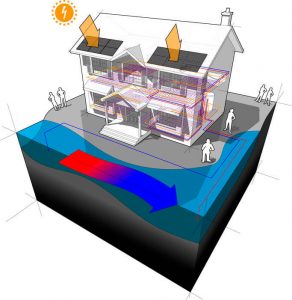 Open-looped heat pump systems are also known as ground water heat systems. This is because the system pumps water from below the ground at a specific temperature.
Open-looped heat pump systems are also known as ground water heat systems. This is because the system pumps water from below the ground at a specific temperature.
Once the temperature is extracted, the water is sent back through the pipes into the ground.
An open-loop system requires constant maintenance and checking to ensure the water is not being negatively influenced.
5. The Pond Heat Pump System
A pond system includes pipe coils being sent to the bottom of a pond where the temperature remains stable.
The main drawback of this heating system is the need for proximity to a pond. Furthermore, the pond needs to be deep enough for the pump to be capable.
6. The Standing Well Heat Pump System
The difference between a pond system and a standing well system is that temperatures can be exchanged using rock formations in the latter system.
In all other ways, it is the same as a ground water heating system.
7. The Air Source Heat Pump Systems
Heat pumps with an air source utilise the principle of vapour compression. This is also known as transporting air to the water heat pump or air to an air heat pump.
The air source pumps utilise external air which produces heat for the property. The system involves four separate elements (condenser, a compressor, an evaporator, and an expansion valve) allowing refrigerant to pass from a liquid state to a gaseous format.
Once the liquid refrigerant passes through the system, the increased temperature transforms it into a gas or vapour while still producing heat.
The vapour passes through the compressor to increase temperature, and then through the expansion valve to enter the property.
The condenser transfers the gas refrigerant into a liquid state once again. The heat produced is sent through the evaporator. In this final phase, the refrigerant is sent to the heat exchanger once again to restart the process.
This operation can be seen in radiators for residential hot water or underfloor heating systems.
What Considerations Need To Be Made Regarding Heat Pumps?
The Heat Pump Maintenance
The average lifespan of a heat pump is twenty years, but the pump requires frequent maintenance to remain operational.
It is recommended that you check specific details of the system annually with a professional installer assessing the system every four years. After an inspection, a professional installer will provide written details regarding the state of the heat pump and an indication of potential problems.
According to research from the Ground Source Heat Pump Association, maintenance criteria for heat pumps are low without any need for crucial security checks.
Of course, it is recommended that one check the parts of the heat pump system before use, including the pipes, the electronic devices, components of fittings, and the pump.
The Warranty
The average warranty for heat pumps range between two and three years; however, this differs according to the type of sub-insurances.
For instance, a heat pump warranty for workmanship can last for approximately ten years. The Quality Assured National Warranties offer various kinds of protection for heat pump usage.
Producers and professional heat pump installers also provide separate types of warranties.
The Incentives
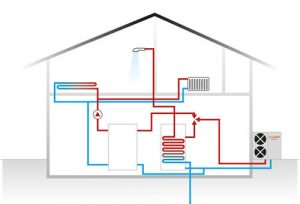 To support UK households in adopting eco-friendly heating solutions and reducing their carbon footprint, the government has introduced the Boiler Upgrade Scheme (BUS). This scheme offers substantial grants to homeowners in England and Wales who install renewable heating systems, such as air or ground source heat pumps.
To support UK households in adopting eco-friendly heating solutions and reducing their carbon footprint, the government has introduced the Boiler Upgrade Scheme (BUS). This scheme offers substantial grants to homeowners in England and Wales who install renewable heating systems, such as air or ground source heat pumps.
The Boiler Upgrade Scheme provides a direct grant to help cover the initial installation costs, making green heating technologies more accessible and affordable. For example, homeowners can receive grants of up to £7,500 for installing air source heat pumps and £6,000 for ground source heat pumps. This initiative is part of the UK’s broader strategy to encourage energy efficiency, support the transition to renewable energy sources, and move towards achieving net-zero carbon emissions by 2050.
Unlike the previous Renewable Heat Incentive, which offered quarterly payments over seven years, the BUS provides upfront financial support. This change aims to simplify the process for homeowners and increase the uptake of renewable heating technologies by reducing the initial financial barrier.
The Planning Permissions For Heat Pump Systems
Since heat pumps typically fall into the category of favourable renewable energy, no planning permissions are required. However, there are some exceptions to this specific rule.
For instance, if you reside in a listed building or conservation area, you must contact the local council to ensure requirements for geothermal heat pumps can be met.
It should also be noted that there are different rules regarding air-source heat pump systems in different regions across the United Kingdom.
Heat Pump Rules For England
Planning permissions for heat pump systems in England must meet the MCS planning regulations. Any additional wind turbines or air source systems need to be considered and reported.
The heat pump cannot be installed on a pitched roof, near the end of a flat roof, or more than one millimetre from the property’s boundary.
Heat Pump Rules For Scotland
If you are installing a heat pump in Scotland, the system must be the only heat pump on that particular property. It must be installed a minimum of 100 metres from other buildings and cannot be placed in listed buildings or heritage sites. If the heat pump is built in a conservation area, the system must not be visible from the road.
Heat Pump Rules For Wales
All installation of air source heat pump systems requires planning permission.
The Cost Of The Heat Pump System
The price of a heat pump is typically high, particularly when taking the installation of the full system into account. Of course, the cost of the different systems varies. The average price for a complete air source heat pump installation ranges between £9,000 and £17,000 (without any operational costs included).
The air to water heat pump system generally begins at £7,000 and increases to £14,000.
Ground source heat pump systems can cost between £9,000 and £12,000.
The operational costs of the systems are dependent on the insulation materials, the size of the system, and the household requirements.
Operational costs are often lower among the ground source heat pump systems, particularly if you change from one system to the other. This will help reduce energy costs while shifting from electricity in the property.
Air Source Heat Pumps
Air source heat pumps are designed to transfer heat from outdoors to indoors and vice-versa.
Air source heat pumps are perfect for offices and homes, especially during the cold winter months.
They’re also ideal for the hot summer months, which is why they are often referred to as reverse-cycle air conditioners.
With that said, here is a guide to air source heat pumps.
What Are Air Source Heat Pumps?
Air source pumps are systems designed to cool your home and heat your home. They are perfect because they can help you and your family remain comfortable, regardless of the climate.
Not only that, but the systems turn solar energy into energy that can be used for domestic purposes.
Homeowners across England and the rest of the UK are huge fans of air source pumps because they are affordable, especially when compared to other systems that provide heating and cooling.
Generally speaking, it costs an average of around £10,000 to install an air source pump. What you’ll pay depends on factors such as the size of the heat pump, the quality of the pump, how big the home is and how well the home is insulated. Homeowners must buy an air source pump that is of high quality.
How Do Air Source Pumps Work?
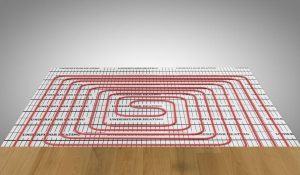 Heat is what air source pumps rely on to create energy. The way they work is simple, they take air from outdoors, and then they transfer it into energy.
Heat is what air source pumps rely on to create energy. The way they work is simple, they take air from outdoors, and then they transfer it into energy.
The heated air can be used for warm air convectors, heating water, underfloor heating systems and radiators.
How well an air source pump will work might depend on whether or not a person buys an air-to-air pump or an air-to-water pump.
Air source heat pumps can function both as an air conditioner and a heater. For those that are after a dual-purpose solution, then an air source heat pump is worth looking at.
In warmer areas, air source pumps are the better option because they are more efficient in warm areas than in colder areas. However, some systems are capable of taking in heat from outside regardless of how cold it is. These systems are known as thermodynamic water heating systems. The downside is they use electricity, which does leave a bit of a footprint on the environment.
Nonetheless, the systems are environmentally friendly. A good option is to use a solar panel system alongside a heating pump. Doing this will reduce carbon footprints.
With that said, there are a couple of systems. The two systems are:
1. Air To Air
Air to air pumps requires the use of fans to distribute air from the outside to inside the home.
One downside to this system is it won’t heat the entire home. It can only provide space heating, but it can be combined with a boiler or a similar system, which means it can then be used for other tasks.
2. Air To Water
Air to water systems has a wet central heating system which is extremely effective. Not only that, but the system can heat water for the home, while at the same time providing heat to areas of the home.
The Pros & Cons of Air Source Heat Pumps
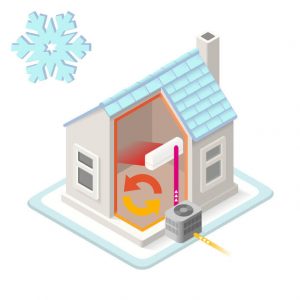 There are pros and cons of air source heat pumps. In short, the pros outweigh the cons. This is why it’s worth buying this kind of system, but people still should learn more about the pros and cons.
There are pros and cons of air source heat pumps. In short, the pros outweigh the cons. This is why it’s worth buying this kind of system, but people still should learn more about the pros and cons.
It is essential to research what options are out there. This is because many brands sell air source heat pumps, but they are not all created equal.
If someone wants a quality air source pump, then they need to buy a product from a reputable brand. Now, let’s discuss the pros and cons.
The Pros
- The upfront costs are not that high. Lots of people are surprised at how inexpensive the systems are. As previously mentioned, the systems are far more affordable than many other alternative systems on the market.
- Air source heat pumps are safe to use. Other heating systems are not always that safe. This is especially true when they are based on combustion.
- The systems are cheap to run. Gas systems can cost a lot, and so can oil boilers. Thankfully, it is very affordable to run air source heat pumps.
- Both types of pumps are easy to install. Other heating systems can be extremely difficult to install. This isn’t the case with air source heat pumps.
- Low carbon footprints. They also are known for low carbon emissions. This isn’t always the case with other heating and cooling systems.
- Not much energy is wasted. This is because it has a 3.2 COP, on average. However, the systems still do a great job.
- Not much maintenance is required. With combustion systems, this isn’t the case. Those systems often require extensive maintenance.
- They function as an AC. When the hot summer months arrive, users can remain cool. This is why more and more people are buying them.
- The lifespan on air source heat pumps is impressive. They do need to be properly maintained. As long as they are maintained, they can last for up to 40-50 years.
- The UK has a Boiler Upgrade Scheme. Buying an air source heat pump means being eligible for this scheme.
The Cons
Although there are many good things about air source heat pumps, there’s a few cons. There’s not many, but nonetheless, there are cons. The main cons and disadvantages include:
- A professional technician needs to install the systems. If a person doesn’t have the experience and the skills, as well as the right tools, then they should not attempt to install an air source heat pump. Only let a professional install this type of system.
- Refrigerants are used in these systems. However, some of the ones used might not be that sustainable. The good news is many systems can use biodegradable resources. When shopping around for a system, make sure to choose one that doesn’t use non-sustainable refrigerants.
- Ice can form, which can interrupt the flow of heat. This can happen when water is produced via condensed air in low temperatures. Water can freeze due to the freezing temperatures.
- If a system isn’t high quality, then the fan that goes outdoors might make a lot of noise. As long as someone buys from a reputable brand, then they shouldn’t have to worry about this. Generally speaking, not much noise will be produced if the air source heat pump is from a good brand.
- A system might not be efficient if the wrong sized pump is used. Before buying a pump, a person needs to make sure they know what size they need. If they don’t know, then they can speak to an expert.
- Traditional heating systems tend to be better when it comes to water temperature. With air source heat pumps, the water’s temperature (maximum temp) is lower than water that the other systems use.
- Before this system can be installed, the homeowner needs permission if the system is going to be installed in Northern Ireland or Wales. In Scotland and England, then this requirement depends on exactly where the homeowner lives. The size of the property plays a role too.
How Much Do Air Source Heat Pumps Cost to Install?
How much one will pay for a pump depends on many factors. Generally speaking, property owners can expect to spend around £10,000, but this price might be lower or higher. It is worth pointing out that the initial costs associated with buying and installing air heat source pumps are more economical than many traditional systems on the market.
Are There Government Grants Available For Air Source Heat Pumps?
Yes, government grants are available for air source heat pumps in the UK, but the scheme has evolved from the Renewable Heat Incentive (RHI) scheme to the newer Boiler Upgrade Scheme (BUS). The RHI scheme, introduced in spring 2014, aimed to encourage the adoption of renewable heating systems, including air-to-water heat pumps, to meet environmental targets and reduce dependence on traditional energy sources.
The Boiler Upgrade Scheme, launched more recently, continues the government’s effort to support renewable energy adoption by offering financial incentives specifically for the installation of air source heat pumps, among other low-carbon heating systems. Under the BUS, homeowners and small business property owners in England and Wales can receive a grant of £7,500 towards the cost and installation of an air source heat pump. This increase in grant funding, effective from 23 October 2023, represents a significant push towards making green heating solutions more accessible and appealing to a wider audience.
The BUS is part of the UK’s broader strategy to reduce carbon emissions and promote energy efficiency in homes and businesses. It reflects the government’s commitment to transitioning to more sustainable energy sources, aligning with the UK’s goal of achieving net-zero emissions by 2050.
How Much Can Homeowners Save With Air Source Heat Pumps?
Investing in air source heat pumps can save both money and energy. On average, an air source heat pump can save a homeowner around £1,200, but some people might save more or a little less.
Ground Source Heat Pumps
What Are Ground Source Heat Pumps?
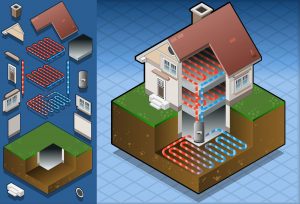 Ground source heat pumps (GSHP) or geothermal heat pumps (GHP) are central heating or cooling systems that transfer heat to and from the ground.
Ground source heat pumps (GSHP) or geothermal heat pumps (GHP) are central heating or cooling systems that transfer heat to and from the ground.
These systems take advantage of the relatively constant temperature in the ground to create, convert and transport the energy to residences, which is then used for different heating purposes.
Ground source heat pumps leverage the renewable, free, and eco-friendly source of energy, a highly appealing aspect in the world today. They are also very durable and call for little maintenance during their lifespan.
This section will cover the most essential aspects of GSHPs, including the types, how they work, pros and cons, the costs involved as well as the installation process.
Can a Ground Source Heat Pumps Be Installed in Your Property?
Heating expenses are something we all dread, especially if you reside in northern England. Getting a GSHP not only allows you to reduce these expenses but ensures you remain cool or warm, depending on the season.
In addition to their durability, they call for little to no maintenance, something uncommon with the standard heating solutions.
If you want to install these systems in your property, it’s first imperative to know the energy requirements. This is crucial as it will help you know what type and size of a geothermal heat pump are excellent for your home. With an ideal pump, you will experience effective heat production by the system as well as less power consumption in your home.
GSHPs are either based on the closed-loop or open-loop system. The latter harness heat from below the ground, which is then transferred through a piping loop that takes it to a pump situated indoors.
What are the Different Types of Ground Source Heat Pumps?
Several types of GSHPs utilise the closed-loop system, including:
1. Vertical GSHPs
Vertical ground source heat pumps are often used in suburban regions where space is limited.
Vertical heat pumps piping system goes down the ground for up to 150 meters, with the depth being dictated by the soil composition and the heating required.
During installation, this piping has to be protected by insulation that’s at least 6m deep.
2. Horizontal GSHPs
Horizontal ground source heat pipes are best suited for installation in rural regions where land size is not an issue.
Installing these systems requires horizontal trenches between 1 and 2 meters to be dug where the piping is to be laid.
To know the size of land you need to install an ideal horizontal GSHP, you need to take into consideration your heating requirements, the climate of the region, the texture and composition of soil as well as the efficiency of the system you wish to install.
3. Closed-Loop Systems That Utilise Lakes or Ponds
Closed-loop systems that utilise lakes or ponds are ground heating pumps that can only be installed in a property that is close to a water body like a pond or lake.
What Other Types of Closed Loop Ground Heat Pumps are There?
There are other systems, but the ones discussed above are the most common in the UK. The others can only be used in places with a constant supply of water, but due to water scarcity, the pumps discussed above are the viable options for UK residents.
How Do Ground Source Heat Pumps Work?
Ground source heat pumps consist of three primary parts:
- The heat pump
- Heat distribution system
- Heat exchanger
For energy production to take place, a mixture containing water and antifreeze or refrigerant is pumped underground by the heat pump. The mixture is continually warmed by the heat underground as it makes its way through the piping.
Once heated, the mixture is passed through a heat exchanger, which absorbs the energy and transfers it to a refrigerant.
The refrigerant boils at a low temperature, thus converting the heat into gas. To increase the temperature of the gas produced, it’s passed through a compressor, heating the water in the piping system. The water is then used for underfloor heating or distributed to radiators.
The gas goes into a condenser where the heat is absorbed and used in the home for heating purposes.
Ground Source Heat Pumps Installation Process
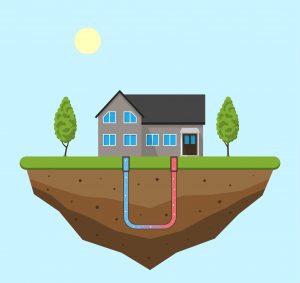
1. Vertical Loop System Installation
Loop fields excavation for the piping is the first step in vertical loop system installation.
The loop is then positioned in well that has been dug, followed by the heat exchanger, which captures the heat absorbed from the ground.
2. Horizontal Loop System Installation
First and foremost, a substantial size of land has to be dug. However, in this type, deep excavation is not required as the loops don’t go as deep.
How Much Do Ground Source Heat Pumps Cost to Install?
As you may have already deduced, there’s an array of factors that affect the cost of buying and installing a ground source heat pump. These include:
- The region that needs heating
- The level of energy consumption
- The extent of insulation in the property.
These three aspects determine the ground heat pump design for a home. In turn, it determines the cost of the right heat pump for your home.
However, according to the Energy Saving Trust, most homeowners should expect to spend anywhere between £13,000 and £20,000 for ground source heat pump installation.
The Groundwork Costs for Horizontal and Vertical Systems Installation
Total groundwork costs for GSHPs installation depends on the kind of system utilised to lay the piping. For instance:
- The horizontal groundwork for a 2-bedroom house can cost £3,000, while the vertical for the same can cost £6,000.
- The horizontal groundwork expense for a 4-bedroom house can be £5,000 and £13,000 for vertical groundwork.
- For a 6-bedroom house, the cost of a vertical system groundwork can go up to £8,000 and $20,000 for vertical groundwork.
The cost goes up with the increase in the number of bedrooms or rather, house size.
Keep in mind that the costs can vary for each case, not to forget other factors such as the nature of the soil and climate in the area.
The Pros & Cons of Ground Source Heat Pumps
The Pros
- Little maintenance once installed
- Efficient in that for every unit of electricity consumed by the pump, 2-4 units of heat are produced, thus making it an efficient way to heat a home.
- They run quietly, meaning no noise disturbances
- They are some of the best sources of renewable and clean energy for heating properties
- Eco-friendly as they give out low levels of carbon
- Highly durable, lasting up to 25 years.
The Cons
- Can be very expensive to buy and install
- The horizontal type call for a large area for installation
- Soil bedrock affects the level of energy that vertical pump systems can produce
- The technology functions at lower temperatures, thus making it most suitable for homes with either huge radiators or underfloor heating
How Efficient are Ground Source Heat Pumps?
As mentioned earlier, these heating pumps harness the heat from the sun trapped underground. The sun gives out a lot of heat that’s stored underground in a relatively stable temperature.
These pumps need very little energy to run optimally, and for every kilowatt they use to function, they produce about 4 kilowatts. This makes them a very cost-effective form of heating and saves homeowners a lot of money in the long haul.
They are environmentally friendly due to the low levels of carbon emission.
Underfloor Heating Systems or Radiators?
To achieve optimum performance of GSHPs, it’s best to install an underfloor heating system. That’s because these systems ascertain even heat distribution across the surface of your house.
To heat the house, you need to have several radiators spread from one corner to another. Radiators produce more heat than their underfloor counterparts. However, heat distribution may fail to be even.
Also, keep in mind that underfloor heating systems tend to cost more than radiators.
Are There Ground Source Heat Pump Grants?
There are three types of grants for ground heat pumps you can get from the UK government. It’s important to know about them as they can save money. These grants include:
1. Boiler Upgrade Scheme
To support UK households in adopting eco-friendly heating solutions and reducing their carbon footprint, the government has introduced the Boiler Upgrade Scheme (BUS). This scheme offers substantial grants to homeowners in England and Wales who install renewable heating systems, such as air or ground source heat pumps.
The Boiler Upgrade Scheme provides a direct grant to help cover the initial installation costs, making green heating technologies more accessible and affordable. For example, homeowners can receive grants of up to £7,500 for installing air-source heat pumps and £6,000 for ground-source heat pumps. This initiative is part of the UK’s broader strategy to encourage energy efficiency, support the transition to renewable energy sources, and move towards achieving net-zero carbon emissions by 2050.
Unlike the previous Renewable Heat Incentive, which offered quarterly payments over seven years, the BUS provides upfront financial support. This change aims to simplify the process for homeowners and increase the uptake of renewable heating technologies by reducing the initial financial barrier.
2. Non-Domestic Renewable Heat Initiative
This is an initiative to compensate people for the cost incurred when installing GSHPs for commercial enterprises.
The payments under this grant are haste and the pump installer is often left to enjoy the benefits of the installation.
3. Energy Company Obligation
This is a GSHP grant that puts legal obligation for energy suppliers to follow the measures put in place to ascertain energy efficiency. As expected, obligations under this grant include minimising heating expenses, reducing carbon emissions as well as community obligations.
Heat Pump Source: Reliable Heating and Cooling Solutions
At Heat Pump Source, we take pride in our unwavering commitment to serving the UK with top-tier HVAC solutions. From the efficiency of heat pumps and the cool relief of air conditioning to the warmth of boilers, radiators, and underfloor heating, our dedicated team is always at the forefront of innovation. We understand the unique needs of every household and business, and we strive to provide dependable health and cooling products and services that are tailored just for you. Ensuring your comfort and satisfaction is our utmost priority. Whether you have questions, need guidance, or require support, we’re always here to assist. Please don’t hesitate to contact us; we’re eager to be of service.
Conclusion
Heat pumps have emerged as a frontrunner in the quest for sustainable and eco-friendly energy solutions, offering both environmental and economic benefits. With various options available, from ground to air source systems, homeowners and businesses can tailor their choices to their specific needs and property characteristics. While the initial investment might seem steep, the long-term savings on utility bills and the longevity and low maintenance of these systems make them a wise choice. Furthermore, with the UK government’s backing in the form of grants and incentives, the transition to these renewable energy systems is becoming increasingly accessible. As we move towards a greener future, heat pumps stand out as a practical, efficient, and environmentally responsible choice for heating and cooling needs.
About the Author
At Heat Pump Source, our articles are the product of a collaborative effort among a team of highly skilled HVAC experts. Our dedicated professionals, hailing from diverse backgrounds in heating, ventilation, air conditioning, and refrigeration, contribute their extensive knowledge and experience to every piece of content. This multidisciplinary approach ensures comprehensive coverage. Our commitment is to deliver authoritative, reliable, and tailored advice to meet the unique needs of every household and business across the UK.

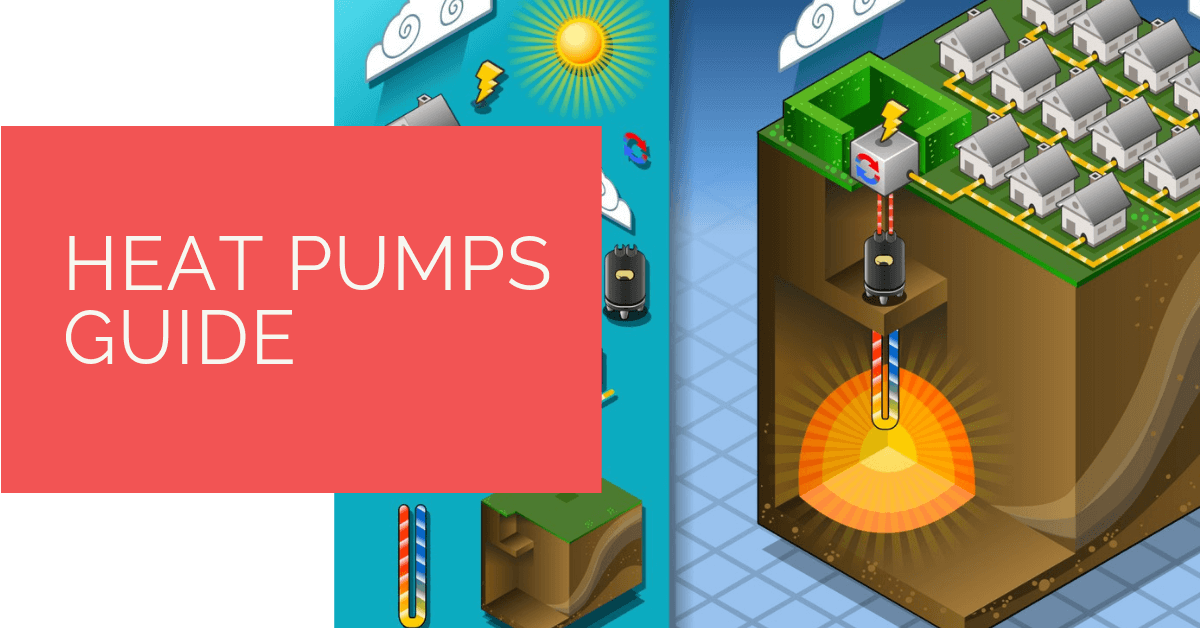
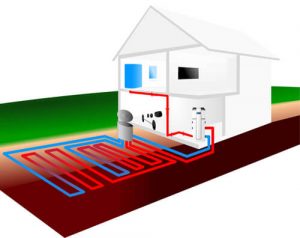 The Vertical Ground Source Heat Pump System
The Vertical Ground Source Heat Pump System